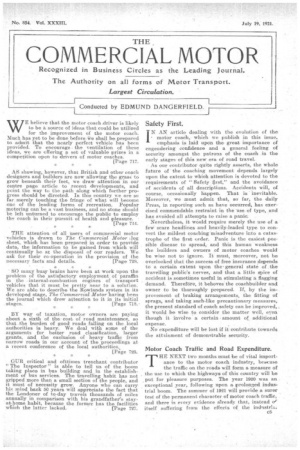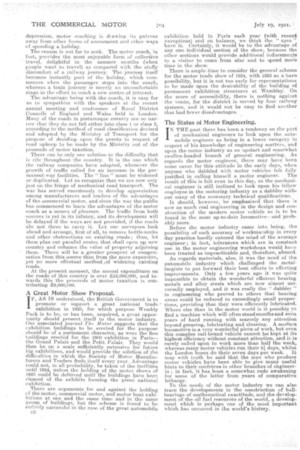Safety First,
Page 1

Page 2

If you've noticed an error in this article please click here to report it so we can fix it.
IN AN article dealing with the evolution of the. motor coach, which we publish in this issue, emphasis is laid upon the great importance of engendering confidence and a general feeling of security amongst the patrons of the coach in the early stages of this new era of road travel.
As our contributor quite rightly asserts, the whole future of ' the coaching movement depends largely upon the extent to which attention is devoted to the requirements of " Safety #.rst," and the avoidance of accidents of all descriptions. Accidents will, of course, occasionally happen. That is ' inevitable. Moreover, we must admit that, so far, the daily Press, in reporting such as have occurred, has exercised commendable restraint in the use of type, and has avoided all attempts to raise a panic. .
Nevertheless, it would require merely the use of a few scare headlines and heavily-leaded type to convert the mildest coaching misadventure into a catastrophe of the #rst order. Panic is the easiest possible disease to spread, and this human weakness the builders and owners of motor coaches would be wise not to ignore, it must, moreover, not be overlooked that the success of free insurance depends to a certain extent upon the general state of the travelling public's, nerves, and that a little spice of accident is sometimes useful in stimulating a flagging demand. Thereto-re, it behoves the coachbuilder and owner to be thoroughly prepared. If, by the improvement of braking arrangements, the fitting of sprags, and taking such-like precautionary measures, the present standard of coach safety can be improved„ it would be wise to consider the matter well, even though it involve a certain amount of additional expense. .
No expenditure will be lost if it. contribute towards the attainment of demonstrable security.
Motor Coach Traffic and Road Expenditure.
THE NEXT two months must be of vital importa,nce to the motor coach industry, beeense the traffic on the roads will form a measure of the use to which the highways of this country will be , put for pleasure purposes. The year 1920 was all exceptional year, following upon a prolonged industrial boom. The summer of 1921 will provide a surer test of the permanent character of motor coach traffic, and there is every evidence already that, instead oi itself suffering from the effects of the indestrie.
depression, motor coaching, is drawing its patrons away from other forms of amusement and other ways of spending a holiday.
The reason is not far td seek. The motor coach, in fact, provides the most enjoyable form of collective travel., delightful in the summer months (when people want to travel) as compaaed with the stuffy discomfort of a railway journey. The journey itself becomes instantly part of the holiday, which commences when the passenger steps into the coach, whereas a train journey is merely an uncomfortable stage in the effort to reach a now centre of interest.
The advantage being with the coach, it is easy for us to sympathize with the speakers at the recent, annual, meeting and conference of Rural District Councils of England and Wales held in London. Many of the roads in picturesque country are • so narrow that they do not fall either into class 1 or class 2, according to the method of Toad classification devised and adopted by the Ministry of Transport for the purpose of deciding. upon the grants in respect of road -upkeep to be made by the Ministry out of the proceeds of motor taxation.
There can be only one solution to the difficulty that is rife throughout the country. It is the one which the railway companies have adopted, whenever the growth of traffic called for an increase in the permanent-way facilities. The " line " must be widened or duplicated. Let us recognize that we are now only just on the fringe of mechanical road transport. The war has served enorthously to develop appreciation among manufacturers and traders of the advantages of the commercial motor, and since the war the public has commenced to learn the advantages of the motor coach as a means of pleasure. The traffic from both sources is yet in its infancy, and its development will be delayed if the. ways are not provided, if the roads al'e not there to carry it. Let. our surveyors look ahead and arrange', first of all, to remove bottle-necks and other obstructions on existing roads; then, let them plan out parallel routes that shall open up new country and enhance the value of property adjoining them. There will be a greater prospect of compensation from, this source than from the more expensive, yet no more effectual method of widening existing ' roads.
At the present moment, the annual expenditure on the roads of this country is over £52,000,000, and towards this the proceeds of motor. taxation is contributing 29,000,000.
A Great Motor . Show Proposal.
Iv, AS ISunderstood, the British Government is to promote or support a great national trade exhibition in 1923, for which purpose Wembly Park is to. be, or has been, acquired, a great opportunity should present itself to the motor industry. Oar associated journal The Motor suggests that the exhibition buildings to be erected for the purpose should be of a. permanent character, as were the fine • buildings erected for the 1900 exhibition in Paris— the Grand Palms and the Petit Palais. They would then be on a scale sufficiently extensive for future big exhibitions, and would provide the solution of the difficulties. in which the Society of Motor Manufacturers and Traders finds itself every year. Advantage could not, in all probability, be taken of the facilities until 1924, unlesa the holding of the motor shows of 1923 could be deferred until the buildings have been cleared of the exhibits forming the great. national exhibition There. are arguments for and against the holding of the motor, commercial motor, and motor boat exhibitions at one and the same time ..and in. the same group of buildings, but the scheme is found to he entirely successful in the case of the great automobile
ca
exhibition held in Paris each year (with recent exceptions) and on balance, we think the "ayes " have it. Certainly, it would he to the advantage of any one individual section of the allow, because the other sections would provide additional incIncemen,ts to a visitor to come from afar and to spend. more time in the show.
There is ample time to consider the general scheme for the motor trade show of 1924, with 1923 as a bare possibility, but it is not too early for representations to be made upon the desirability of the building of permanent exhibition structures at Wembley'. On the score of accessibility., there is nothing against the venue, for the district is served by four railway systems, and it would not be easy to find another that. had fewer disadvantages. ,
The Status of Motor Engineering.
INI THE past there has been a tendency on the part of mechanical engineers to look upon the automobile engineer as being in a lower category in respect of his knowledge of engineering matters, and upon the motor industry as an upstart and some:What swollen-headed branch of general' engineering. As regards the motor engineer, there may have been some cause for this attitude in the early days, when anyone who dabbled with motor vehicles felt fully justified in calling himself a. motor engineer. The result of this is felt even to this day, as the mechanical engineer is still inclined to look upon his fellow employee in the motoring industry as a dabbler without many of the necessary technical qualifications. It should, however, be emphasized that there is now as much real engineering in. the design and COillstruction of the modern motor vehicle as is to be found in the most up-to-date Iocomotiveand probably more.
Before the motor industry came into being, the possibility cifi suCh accuracy of workmanship in every day practice hardly entered the mind of the average engineer; in fact, tolerances which are in constant use. in the motor engineering workshops would have been treated as impracticable and, therefore, absurd.
As regards materials, also, it was the need of the automobile industry which challenged the metallurgists to put forward their best efforts in effecting improvements. Only a few years ago it was quite impossible to obtain the wonderful efficient, bearing metals and alloy steels which are now almost universally employed, and it was realty thD " dabbler" in engineering who proved to others that bearing areas could be reduced to exceedingly small proportions, providing that they were efficiently lubricated. Where else than in the motor world is it possible to find a machine which will often standmonthsand even years of hard running with scarcely any attention beyond greasing, lubricating and cleaning, A modern locomotive is a very wonderful piece of work, but even this complex rail-bound vehicle cannot be kept A its highest efficiency without constant Wendell, and it. is rarely called upon to work more than half the week, whereas many motor vehicles run their 5.days, whilst the London buses do, their seven days per week. It may with truth be said that the men who produce motor vehicles have been able to give many useful hints to their confreres in other branches of engineerin ; in fact, it has been a. somewhat rude awakening for some of the latter from years of comparative lethargy. To the needs of the motor industry we can also trace the developm,ents in the construction of ballbearings, of inathemaficai exactitude, and the development of the oil fuel resources of the world, a development which is perhaps one of the most important which has occurred in the world's history.
































